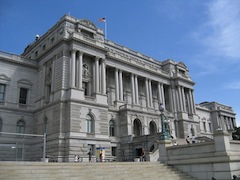This past summer, the Library of Congress issued a number of exemptions to the Digital Millennium Copyright Act (DMCA), one of which made it legal for academics to rip clips from DVDs, for use in their teaching or publishing.
Since June of 2009, Vassar has had a streaming media server that can deliver video clips to Moodle (and more recently to WordPress). The Wowza software streams video content quickly and beautifully anywhere on campus (best if using a wired connection). We were very excited to share this technology with the faculty, especially faculty members who work extensively with video. Faculty members who used our streaming server delighted in having the resources available via Moodle. The videos look great viewed on laptops or desktop machines. Streaming from Moodle during class made for a convenient teaching situation as there was no need to switch video sources or fumble with DVD or VHS controls. ACS envisioned a radical transformation of the Library Reserve desk where students could watch and re-watch films for class, on demand, and at their leisure. Students would not be tied down to three-hour reserve deadlines (or finding the video already signed out). Faculty members wouldn’t be troubled trying to arrange screenings for classes. The on-demand streaming video revolution that has transformed the outside world via Netflix and Hulu would now come to our campus!
Unfortunately, our fanciful visions melted to clouds of despair as UCLA came under attack from the Association for Information and Media Equipment. AIME’s accusations of copyright violation caused UCLA to suspend its streaming video service while they worked out the legal dispute. Educational institutions from all over the U.S. paid close attention, including Vassar. ACS had to reconsider how to inform the faculty about Vassar’s streaming media server, as our new policy restricted how we stream copyrighted material. There were more than a few awkward conversations with faculty members who had grown quite fond of our Wowza server, not to mention their concern about the time and effort put into curating video resources for their classes.
Since this summer, when it comes to clips, ACS can once again legally stream video ripped from DVDs. The Library of Congress exemptions impacted a number of areas, but the proviso that impacts scholars ripping DVDs reads as follows:
(1) Motion pictures on DVDs that are lawfully made and acquired and that are protected by the Content Scrambling System when circumvention is accomplished solely in order to accomplish the incorporation of short portions of motion pictures into new works for the purpose of criticism or comment, and where the person engaging in circumvention believes and has reasonable grounds for believing that circumvention is necessary to fulfill the purpose of the use in the following instances:
(i) Educational uses by college and university professors and by college and university film and media studies students;
(ii) Documentary filmmaking;
(iii) Noncommercial videos.
In summary, clip-ripping portions of DVDs for academic fair use is legal. All previous laws and guidelines about the sharing of copyrighted material remain; what is new is that educators are no longer banned from the act of ripping materials from a copy-protected DVD. It is also legal for documentary filmmakers and creators of video not intending to make profit. If you are interested in learning how to rip clips yourself, I recommend this great guide for ripping DVD. You can also contact your ACS liaison for assistance in curating clips and how best to use them in your teaching.
If you’d like to learn more about how the recent exemptions impact the flow of information and pedagogy in the 21st century, I recommend this interview with Abigail De Kosnik, Gary Handman and Mark Kaiser of University of California, Berkeley.






